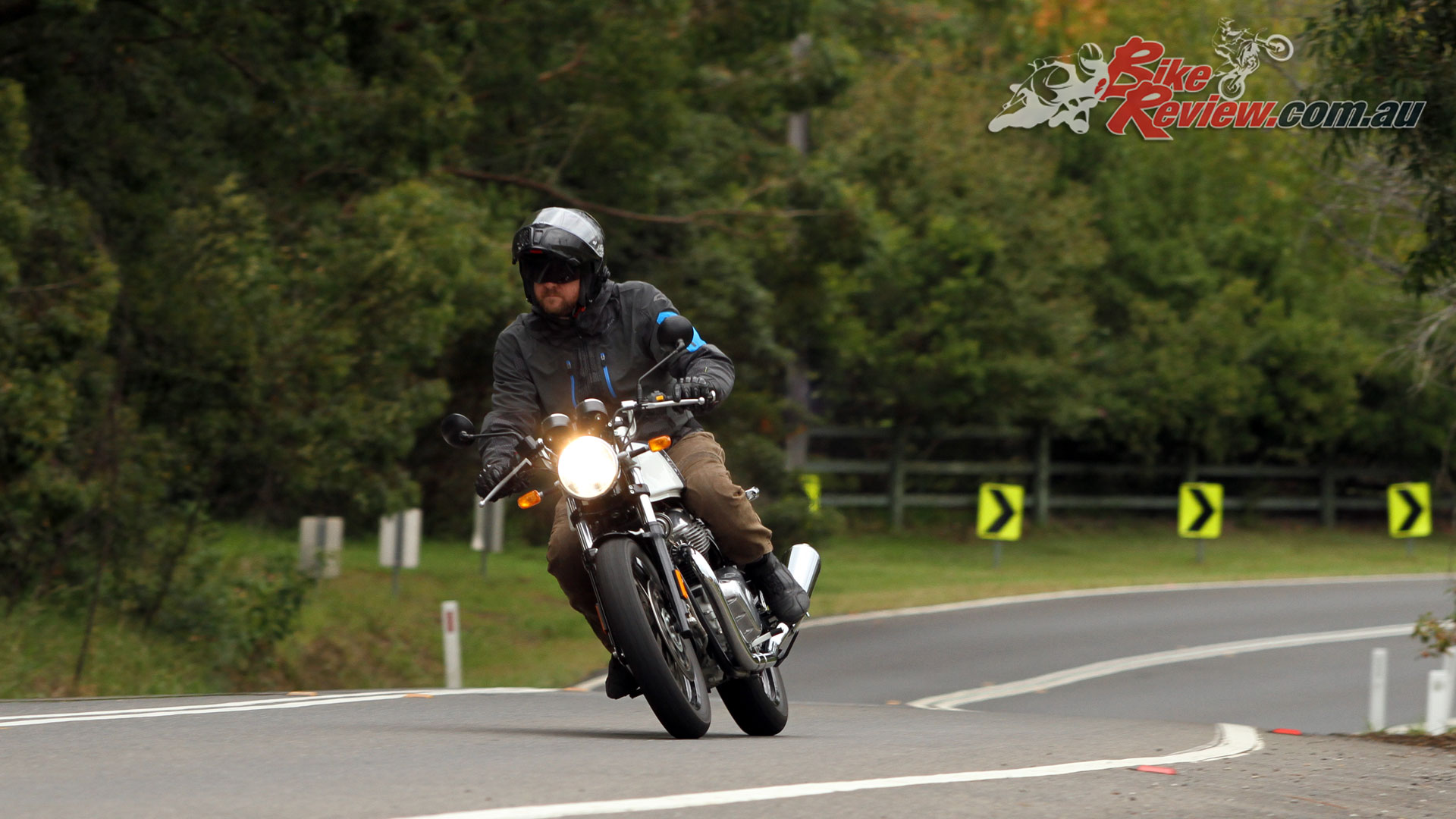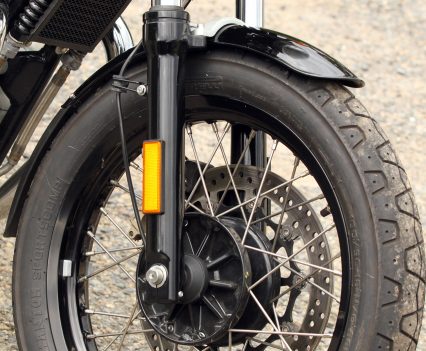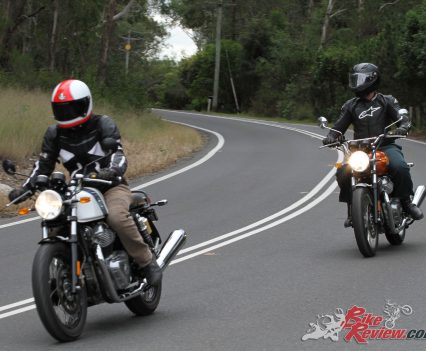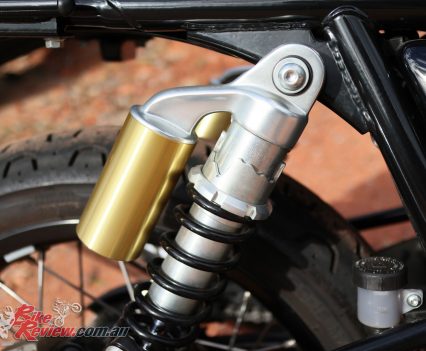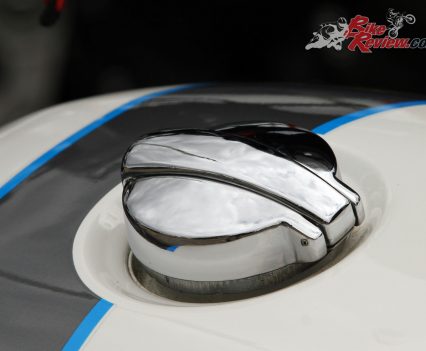Having recently tested the Royal Enfield Interceptor, Kris takes a look at the Cafe Racer styled Continental GT 650, which offers sportier ergonomics....
Having recently tested Royal Enfield’s Interceptor INT 650 and come away impressed, I was interested to see just how the Continental GT stacks up, as in the past, some quite modest changes between models has proven a bit of a transformation to the character of the bike.
Picking the bike up in Sydney I grabbed the keys and was told the bike had been checked over mechanically and washed, but there was faint corrosion on the engine and even having been washed and obviously gone over thoroughly – it looked like this press bike had had a hard life.
Setting off through inner-City Sydney I’m soon at home on the bike, which feels a bit more compact than the Interceptor, due to the lower seat height, sportier drawn back ‘bars and rearward footpeg position. The engine is smooth from a stop and the bike feels nimble and easy to throw around, where the Interceptor had a definite air of stability in contrast despite the same geometry.
The commute home took about an hour, giving me the opportunity to see how the Continental GT 650 handled the more day to day duties that commuting presents, with the bike easy to handle in heavy traffic conditions and easily capable of staying ahead of the traffic, or weaving through it. I still wasn’t a huge fan of the round mirrors as the field of view they offer is limited but it’s style over function.
With the Continental GT 650 feeling a bit of a sharp turner with a very light front-end feel, I was at first a bit unsure how it would handle some of the road surfaces I found, including mis-matched road surfaces where some road worker had done a good impression of a patchwork quilt, or road plates, but it was all manageable in the sunny and dry conditions Sydney had laid out. Both of the 650 twins do have a habit of tracking along road inconsistencies however.
One area that was in stark contrast to riding the Interceptor though was the front brakes, which had poor initial bite and little power, meaning that the powerful rear brake had to be heavily relied on. It’s a weird contrast too, because the brakes on the Interceptor were great and they both run exactly the same system. Glazed pads perhaps…?
ABS is standard fitment of course, which is a boon to new riders in particular, and is most likely to be noticed in slippery conditions, as the brakes aren’t overwhelming, even when in tip top shape.
Getting home I pulled out the polish for all the painted sections and gave the chrome and engine a good wipe down ready for photos, with my own bikes staring forlornly and dirtily at me. This helped bring back that eye-catching retro quality, but this probably does suggest that being left out in the rain and not given a bit of TLC, may prematurely age these bikes compared to the Japanese and European competition.
With that said, the lack of plastic and solid design and manufacturing also suggests these machines are built to last (though apparently you can replace an engine cheaply as a part number), so while you might end up with a patina of age, it’s certainly not a bike that feels cheap, or flimsy, especially for the price point.
The following day offered an opportunity to put the Continental GT 650 to the test for the day, where that more sportsbike-like ergo really came to the fore, helping make the ride feel more engaging if you’re the type to tuck in and simulate your favourite racer on a retrobike. A nice aspect is that on the moderate pace smooth, twisty motorcycling roads you don’t really need to be going at a breakneck pace to enjoy that sporty sensation either.
The Continental GT 650 lives up to those clip-on style ‘bars and more rearset like ‘peg position, however there wasn’t quite the same level of stability as on the Interceptor. It may have just been the poor road surfaces in some sections however, as the rear shocks really took a beating at times, transferring a fair bit of that back through the bike.
The GT shocks are set with a step more preload than on the INT 650, with room for adjustability, while the forks felt similar between models – excluding the ergonomic changes – but were under a lot less stress or compression in many situations due to the lack of front braking power, which had me using the gearbox and rear brake a lot more, as well as braking much earlier.
The ‘bars are also mounted directly to the forks with clip-on style risers, which are a nicely finished detail and I did notice the vibrations a little more on the GT than the Interceptor at times, without falling prey to numb hands or discomfort.
Luckily the seat is well padded despite being quite thin, with a foam that is just the right density and only extended periods start to cause some discomfort, which is true on pretty much anything, while the overall ergonomics despite being more aggressive, are still relatively upright, open and relaxed. It’s certainly not full café racer, but there’s a real point of difference between the two models.
This particular 650 twin also felt a little softer on power delivery through the throttle than Jeff’s Interceptor, although I only ran 95 Octane, with 98 seeming a stretch for this kind of bike, especially with prices nearing the $2 mark during testing. Jeff put a tank of 98 through the bike after my test, noting there was still a performance difference between the two bikes. This could just be a run-in thing as Jeff had his done professionally at Sydney Dyno, but with that said there was still a good spread of power throughout the rev range, with a nice light clutch and smooth take-off. No doubt the slip and assist clutch really benefited the lever action, as well as helping reduce the chance of compression lock-up into turns. It’s a sweet motor in every way.

Performance from the Royal Enfield 650 twin is plentiful with strong acceleration and a sporty character
The Continental GT 650 was still pulling strongly well past conventional speeds too, and fueling is nice and smooth, with that lovely throttle to power connection that ensures you feel involved, where some of the new RbW systems have a bit of a mind of their own.
Another standout was the gearbox and shifting. On the Interceptor this was the weak point, with some play in the linkage that occasionally made it hard to get into neutral. In comparison the Continental GT 650 shifter is bolted straight on to the selector shaft, and there can’t be any complaint in this area as a result, with solid engagement and an easy action.
With all that said there was plenty I really liked about the Continental GT 650, the ergonomics were more to my taste, and instantly clicked when I jumped on board, and I really liked the bike for the suburban conditions. The tank without badging also seemed a little more premium to me even if the sticker seemed to be on the outside of the clearcoat and was gathering a bit of dirt along the edges.
The brake issue meant that while the Interceptor 650 really wowed me, the Continental GT 650 didn’t have quite the same edge, but the two bikes both share some noticeable features, as well as providing significantly different rides and character, which really justifies the two model variants.
At the end of the day, the new Royal Enfield 650 twin powerplant is a winner in my books, and whether you want a stock retro themed machine, or a great basis for a custom bike, the manufacturer seems to be on the right path to meeting the needs of many modern riders.
ROYAL ENFIELD CONTINENTAL GT 650 TECH TALK
The Royal Enfield 650-twins are powered by the first modern Royal Enfield two-cylinder engine. This new platform is a single overhead cam, eight-valve, air/oil-cooled, 648cc parallel twin, producing 47bhp and 52Nm, with the brand aiming to retain the Royal Enfield character of accessible torque through the rev range. A 270º firing order crankshaft helps create the 650’s character, with a Bosch EMS/EFI setup and 9.5:1 compression ratio.
The Continental GT 650 is equipped with classic 18” front and rear Pirelli Phantom tubed tyres (100/90-18, 130/70-18) on 36 spoke alloy rims, and twin shock absorbers, along with front and rear disc brakes with ABS. Calipers are by Bybre, Brembo’s second tier braking brand, with a traditional master-cylinder and no adjustable levers. A seat height of 793 mm offers a 9mm lower perch than the Interceptor, with ground clearance 174mm.
Forks are 41mm non-adjustable units with 110mm travel, with a single round front headlight and retro indicators. Dual low exhausts are also featured in chrome, while the Continental GT 650 has a smaller 12.5L fuel tank, and weighs in at 198kg.
The six speed gearbox, especially developed for this motorcycle is augmented by its ‘slip/assist’ clutch, that facilitates easy riding in traffic with a light feel, and prevents wheel-hop when downshifting gears and is first for Royal Enfield. The chassis has been developed from the ground up by the team at Royal Enfield’s UK Technology Centre, and Harris Performance, with am all-new, dedicated steel-tube cradle chassis. Unlike the Interceptor the Continental GT 650 features clip-on style risers.
A single-piece seat is also featured, with a toolkit in the side panel. Dual clocks are analogue with a digital display with electric start and the Continental GT 650 is Euro4 compliant.
2019 ROYAL ENFIELD CONTINENTAL GT 650 SPECIFICATIONS
Price: From $9,990 On-Road
Warranty: 3 year factory warranty & 3 year roadside assistance
Claimed power: 47hp@7250rpm
Claimed torque: 52Nm@5250rpm
Weight: 198kg wet
Fuel capacity: 12.5L
Engine: SOHC air-cooled 648cc parallel twin four-stroke, eight-valve, 78mm x 67.8mm bore x stroke, 9.5:1 compression, 270º firing order crankshaft, Bosch EMS/EFI
Gearbox: Six-speed constant mesh
Clutch: Wet multi-plate slipper clutch, cable actuation
Frame: Double-cradle tuned tubular steel frame
Rake: 24°
Trail: 105mm
Suspension: 41mm forks, 110mm travel, twin shock, 88mm travel, rear preload adjustment
Brakes: 320mm stainless steel floating rotor (f), ABS, two-piston sliding ByBre caliper, Bosch ABS, conventional master-cylinder, 240mm rotor (r), ByBre caliper.
Wheels & Tyres: 36 spoke alloy rim 2.50 x 18in, 36 spoke alloy rim 3.50 x 18in, Pirelli Phantom 100/90-18, 130/70-18.
DIMENSIONS:
Wheelbase: 1400mm
Seat height: 793mm
Ground clearance: 174mm
Overall width: 744mm
Overall Length: 2122mm
Overall height: 1024mm
Instruments: Dual clocks, tacho, speedo, dual trip, warning lights/fuel.
Electronics: Bosch Two-Channel ABS, Bosch EMS.
2019 ROYAL ENFIELD CONTINENTAL GT 650 Gallery
The Verdict | Review: 2019 Royal Enfield Continental GT 650 Twin
Retro Cool
In the Continental GT 650 Royal Enfield offer a sportier take on their 650 twins, with clip-on style ‘bars, and sportier rearset style foot controls, in a package that lends the learner legal twin a definite aggressive edge and is ideal for those who fancy themselves heading in the cafe racer direction.





